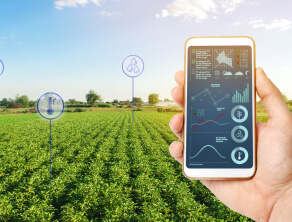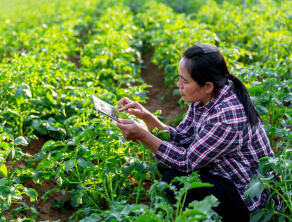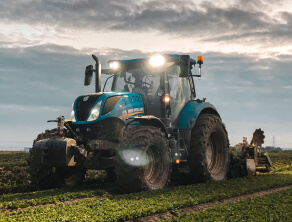All You Need to Know About Industrial Agriculture.

Introduction:
Industrial agriculture, or industrial farming, is a modern farming system characterized by large-scale, intensive production methods using advanced technology and chemical inputs. It aims to maximize efficiency and yield by utilizing mechanization, genetic engineering, synthetic fertilizers, and pesticides.
Industrial agriculture is prevalent worldwide and has significantly transformed food production, making it a dominant force in the global food supply chain.
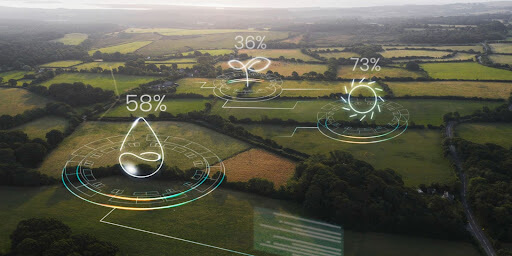
Overview of Industrial Agriculture:
In industrial agriculture, large monoculture fields and factory farms dominate the landscape. These vast expanses are dedicated to growing a single crop or raising a specific type of livestock. This approach prioritizes mass production and cost-effectiveness, but it often comes at the expense of environmental and ethical considerations.
- Mechanization and Technology: Industrial farming heavily relies on machinery and technology to streamline production processes. Tractors, harvesters, and other advanced equipment enable farmers to manage vast areas with minimal labor requirements.
- Chemical Inputs: Synthetic fertilizers and pesticides play a central role in boosting crop yields and protecting them from pests and diseases. However, the excessive use of these chemicals can lead to soil degradation, water pollution, and harm to non-target organisms.
- Genetic Engineering: Industrial agriculture often employs genetically modified organisms (GMOs) to enhance crop traits such as resistance to pests, diseases, and herbicides. While this can increase productivity, it raises concerns about the long-term impact on biodiversity and human health.
- Economies of Scale: Industrial farming capitalizes on economies of scale to reduce production costs. This allows for cheaper food prices but can lead to a concentration of power in the hands of large agribusiness corporations, disadvantaging smaller farmers.
- Environmental Concerns: The extensive use of chemical inputs and monoculture practices can contribute to soil erosion, loss of biodiversity, and water pollution. Additionally, the high demand for water in industrial farming can exacerbate water scarcity in certain regions.
- Animal Welfare Issues: Factory farming, a subset of industrial agriculture, involves raising animals in confined and intensive conditions. This practice has raised ethical concerns about the treatment and welfare of livestock.
While industrial agriculture has significantly increased food production, it faces mounting criticism for its environmental impact, potential health risks, and disregard for sustainable farming practices. As the world grapples with the challenges of feeding a growing population while preserving the planet’s resources, alternative and more sustainable agricultural approaches gain traction as potential solutions.
The Importance of Industrial Farming in Modern Food Production
Industrial farming, also known as industrial agriculture, plays a pivotal role in meeting the growing demands of the modern world’s population. This method of food production utilizes advanced technologies, large-scale operations, and efficient processes to produce a significant portion of the global food supply.
High Productivity and Efficiency:
Industrial farming techniques are designed to maximize productivity and efficiency. Large quantities of crops and livestock can be produced relatively quickly through mechanization, automated processes, and modern agricultural machinery. This ensures a steady and abundant food supply to meet the increasing global population’s needs.
Cost-Effectiveness:
With its focus on mass production, industrial agriculture optimizes economies of scale. Producing food in large quantities decreases the cost per unit, making food more affordable for consumers. This cost-effectiveness benefits individuals and contributes to stable food prices in the market.
Enhanced Crop Yields:
Industrial farming has significantly improved crop yields through the application of scientific advancements. Genetically modified organisms (GMOs), precision agriculture, and crop rotation methods are some of the innovations that have boosted agricultural productivity. Increasing crop yields can preserve more land, reducing the pressure to convert natural habitats into farmland.
Sustainable Resource Management:
Contrary to conventional belief, modern industrial farming practices are committed to sustainable resource management. These practices minimize environmental impact while maximizing crop output by adopting precision irrigation systems, efficient fertilizer usage, and integrated pest management.
Reliable Food Supply:
A consistent and reliable food supply is vital to avoid food shortages and hunger crises. Industrial farming’s large-scale production helps stabilize food availability, reducing the risk of food scarcity during adverse weather conditions or economic challenges.
Support for the Livestock Industry:
The livestock industry heavily relies on industrial farming to produce meat, dairy, and other animal-derived products sustainably. By employing advanced breeding techniques and proper animal welfare practices, industrial agriculture ensures a continuous and humane supply of livestock products.
Technological Innovation:
Industrial farming thrives on technological innovation. As a result, it drives research and development in the agricultural sector, leading to novel advancements in biotechnology, crop protection, and sustainable farming practices. This ongoing progress contributes to the overall improvement of global food production systems.
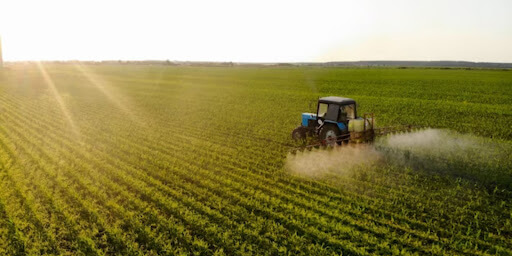
History and Evolution of Industrial Agriculture
1: The Origins of Industrial Agriculture
Industrial agriculture traces its origins to the 18th and 19th centuries during the Agricultural Revolution. The invention of agricultural machinery, such as the seed drill and plow, enabled farmers to mechanize their processes, significantly increasing productivity.
This marked the shift from subsistence farming to surplus production for trade and consumption, laying the groundwork for industrial agriculture.
2: Technological Advancements and Green Revolution
The 20th century witnessed substantial advancements in agricultural technology, known as the Green Revolution. Pioneered by Norman Borlaug and other scientists, this movement introduced high-yielding crop varieties, chemical fertilizers, and pesticides. Industrial agriculture embraced these innovations, dramatically increasing crop yields and food output.
3: Consolidation and Agribusiness Expansion
Post-World War II, the agricultural landscape saw a consolidation of farms into more giant agribusinesses. Industrial agriculture adopted a more standardized and specialized approach, focusing on monoculture and economies of scale. Large corporations and conglomerates began dominating the industry, streamlining production and distribution processes.
4: Intensive Livestock Production
Industrial agriculture also revolutionized livestock farming. Traditional pastoral practices evolved into concentrated animal feeding operations (CAFOs), where large animals are raised in confined spaces. This approach prioritized efficiency and cost-effectiveness, but concerns about animal welfare and environmental impacts soon emerged.
5: Environmental and Social Impacts
The widespread adoption of industrial agriculture brought significant environmental challenges. Excessive use of chemical fertilizers and pesticides led to soil degradation and deforestation. The shift from small-scale farming to industrialized operations profoundly affected rural communities.
6: Criticisms and Sustainable Alternatives
As concerns about the negative consequences of industrial agriculture grew, critics called for more sustainable practices. Organic farming, permaculture, and agroecology emerged as alternatives focusing on ecological balance, reduced chemical inputs, and regenerative practices.
These approaches aim to minimize the environmental impact while promoting social and economic resilience.
7: Future Prospects and Innovations
The future of industrial agriculture lies in striking a balance between meeting the world’s growing food demands and preserving the environment—advancements in precision agriculture, genetic engineering, and vertical farming promise to sustainably increase productivity.
Collaborative efforts between policymakers, farmers, and consumers are crucial to shaping a resilient and responsible agricultural future.
Key Characteristics of Industrial Agriculture
Large-scale production and standardized methods
In modern agriculture, industrial agriculture, also known as industrial farming, plays a crucial role in meeting the ever-increasing global demand for food. This method involves large-scale production and standardized processes to enhance efficiency and productivity.
Intensive Land Use
To optimize production, industrial farming practices concentrate on intensive land usage. Large monoculture fields and confined animal feeding operations are standard features of this system.
Dependence on Chemical Inputs
Industrial agriculture relies heavily on synthetic fertilizers, pesticides, and herbicides to control pests and boost crop growth. These chemical inputs maximize output but can harm the environment and human health.
Mechanization and Automation
Industrial farming heavily employs modern machinery, such as tractors, combines, and automated irrigation systems, to reduce labor costs and increase efficiency.
Genetic Modification
Genetically modified organisms (GMOs) are frequently used in industrial agriculture to create crops with enhanced traits, such as resistance to pests and diseases, further increasing productivity.
Standardization of Crops and Livestock
Uniformity is a hallmark of industrial agriculture. Farmers often grow genetically similar crops and raise uniform livestock breeds to facilitate consistent management and harvest.
Global Distribution and Supply Chains
Industrial agriculture fosters extensive global supply chains to transport produce and livestock to distant markets, ensuring a year-round food supply.
Environmental Impact
The intensive use of chemicals, deforestation for expansion, and greenhouse gas emissions contribute to environmental issues like soil degradation, water pollution, and climate change.
Reduced Biodiversity
The focus on monoculture and standardized livestock breeds diminishes biodiversity, making the agricultural system vulnerable to disease outbreaks and other threats.
Social and Economic Implications
While industrial agriculture can provide affordable food to a growing population, it has also raised concerns about income disparities, labor conditions, and the consolidation of power among a few large corporations.
Environmental Impact of Industrial Agriculture
Discover the true environmental impact of industrial agriculture and industrial farming practices. Learn about the significant consequences of these intensive farming methods on the planet and the ecosystem.
Soil Degradation
Industrial agriculture practices often involve extensive monocropping and heavy use of chemical fertilizers and pesticides, which can lead to soil degradation and loss of fertility.
Water Pollution
Explore how industrial farming contributes to water pollution through agrochemicals and animal waste runoff, posing severe threats to aquatic ecosystems and human health.
Biodiversity Loss
Uncover the alarming decline in biodiversity caused by industrial agriculture, which destroys natural habitats and disrupts ecosystems, jeopardizing the survival of various plant and animal species.
Greenhouse Gas Emissions
Learn about the significant role of industrial farming in contributing to greenhouse gas emissions, exacerbating climate change, and its adverse effects on global weather patterns.
Deforestation
Discover how industrial agriculture drives deforestation to create more agricultural land, leading to habitat destruction, loss of carbon sinks, and threats to indigenous communities.
Energy Consumption
Explore the high energy demands of industrial farming operations, from machinery usage to processing and transportation, and the resulting strain on finite energy resources.
Land Use Conversion
Understanding the impact of converting natural ecosystems into farmland disrupts ecological balances and poses challenges for sustainable land management.
Eutrophication
Learn about the consequences of excessive nutrient runoff from industrial farms, causing eutrophication in water bodies and creating dead zones devoid of aquatic life.
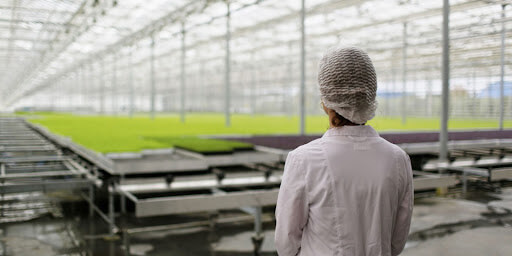
Sustainable Alternatives and Solutions
Agroecology: The Key to Sustainable Farming
Agroecology offers a holistic approach to farming that emphasizes biodiversity, natural resource conservation, and ecological balance. By promoting crop rotations, intercropping, and the use of beneficial insects, agroecology can reduce the need for chemical pesticides and synthetic fertilizers, thereby minimizing environmental damage and increasing long-term productivity.
Organic Farming: Chemical-Free Nourishment
Organic farming eliminates synthetic chemicals, opting for natural alternatives to control pests and enhance soil fertility. By relying on composting, cover cropping, and crop rotation, organic practices contribute to soil health and biodiversity, resulting in healthier produce for consumers and a safer environment.
Precision Agriculture: Smart Farming for Optimal Yields
Precision agriculture leverages modern technology, including sensors, drones, and data analytics, to optimize resource use. By precisely managing irrigation, fertilization, and pest control, this method minimizes waste, conserves water, and reduces chemical application, making it an efficient and eco-friendly alternative to traditional farming practices.
Permaculture: Designing Harmony in Agriculture
Permaculture involves designing agricultural systems to mimic natural ecosystems, creating sustainable and self-sufficient landscapes. By integrating diverse plants and animals, permaculture maximizes resource utilization, conserves water, and builds resilient ecosystems that thrive without chemical inputs.
Aquaponics and Hydroponics: Resource-Efficient Cultivation
Aquaponics and hydroponics are innovative soilless farming methods that recycle water and nutrients, using fish waste to fertilize plants. These closed-loop systems save water, reduce pollution, and enable year-round crop production, making them suitable alternatives for sustainable urban agriculture.
Regenerative Agriculture: Healing the Land
Regenerative agriculture focuses on restoring and enhancing soil health, increasing carbon sequestration, and promoting biodiversity. By incorporating cover cropping, no-till farming, and rotational grazing, it mitigates climate change, improves water retention, and increases overall ecosystem health.
Community-Supported Agriculture (CSA): Building Local Food Networks
CSA fosters direct connections between consumers and local farmers, reducing food miles and promoting community involvement in agriculture. By supporting CSA initiatives, consumers can access fresh, seasonal produce while providing stable income to farmers, encouraging more sustainable farming practices.
Policy and Regulation
- Price supports: The government provides financial support to farmers to ensure they receive a fair crop price. This can encourage farmers to produce more food, lowering consumer prices. However, it can also lead to overproduction and environmental problems.
- Subsidies for inputs: The government provides financial support to farmers to purchase information such as seeds, fertilizer, and pesticides. This can reduce the production cost for farmers, making it more profitable for them to produce food. However, it can also lead to overuse of inputs, which can have negative environmental impacts.
- Regulations on environmental protection: The government regulates the use of pesticides and fertilizers to protect the environment. This can help to reduce pollution and water contamination. However, it can also increase the cost of production for farmers.
- Regulations on food safety: The government regulates the production and processing of food to ensure that it is safe for consumers. This can help to reduce the risk of foodborne illness. However, it can also increase the cost of production for farmers.
- Regulations on animal welfare: The government regulates the treatment of animals in agriculture. This can help to ensure that animals are treated humanely. However, it can also increase the cost of production for farmers.
These are just some government regulations and subsidies that influence industrial agriculture. The specific rules and offerings vary from country to country.
Here is some data on the impact of government regulations and subsidies on industrial agriculture:
- A study by the World Bank found that government subsidies for agricultural inputs can increase production by 10-20%.
- A study by the Food and Agriculture Organization of the United Nations found that government regulations on environmental protection can reduce water pollution by up to 50%.
- A study by the Centers for Disease Control and Prevention found that government regulations on food safety can reduce the risk of foodborne illness by 50-70%.
- A study by the Humane Society of the United States found that government regulations on animal welfare can reduce the number of animals raised for food by 50-70%.
These studies suggest that government regulations and subsidies can significantly impact industrial agriculture. They can increase production, reduce pollution, improve food safety, and protect animal welfare. However, it is essential to note that these regulations and subsidies can also increase the cost of food for consumers.
Government regulations and subsidies influence industrial agriculture in various ways. These regulations and contributions can positively impact the environment and animal welfare, but they can also increase the cost of food for consumers.
Conclusion
In conclusion, Industrial agriculture, also known as industrial farming, has revolutionized the global food production system, leading to increased efficiency, higher yields, and lower costs.
This method for large-scale agriculture utilizes advanced technologies and practices to meet the ever-growing demand for food worldwide. However, it is essential to recognize that industrial agriculture raises concerns about environmental impact, sustainability, and ethical implications.
As we delve deeper into the complexities of industrial agriculture, it becomes evident that finding a balance between productivity and sustainability is crucial for our planet’s future and future generations’ well-being.
Optimizing our agricultural practices, embracing more sustainable methods, and supporting initiatives that promote environmental responsibility can help us work towards a more resilient and eco-friendly food production system.
Stay informed about the latest advancements in industrial agriculture, as well as the efforts being made to address its challenges. We can collectively contribute to a more sustainable and food-secure future by staying informed and supporting responsible farming practices.
Remember, industrial agriculture and farming play a significant role in our lives, impacting our food, environment, and global economy. Let us remain conscious of these impacts and strive towards a more sustainable and balanced approach to agriculture, ensuring a prosperous future for humanity and our planet.
![Blog-[x]cube LABS](https://d6fiz9tmzg8gn.cloudfront.net/wp-content/uploads/2016/06/blog_banner.jpg)



